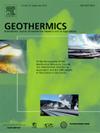Heat flux evaluation based on active fiber optic distributed temperature sensing tests in southwestern Yukon, Canada
IF 3.5
2区 工程技术
Q3 ENERGY & FUELS
引用次数: 0
Abstract
Geothermal energy could decrease remote regions dependence on diesel by offering an alternative baseload energy. However, the geothermal exploration risk is high in remote regions due to limited temperature and ground thermal conductivity data, and resultant heat flux evaluations. Thermal response tests are commonly used in the heat pump industry to evaluate the effective thermal conductivity, but these tests are typically performed in shallow wells (< 200 m), assume the effective thermal conductivity to be purely due to conduction and neglect the influence of groundwater flow. Herein, fibre-optic distributed temperature sensing was used during active thermal response tests to produce a high-resolution in-situ effective thermal conductivity profile. The high-resolution profiles allow conduction-dominated segments to be isolated based on the temperature and effective thermal conductivity profiles. This method was applied to two boreholes in southwestern Yukon on the traditional territory of Kluane First Nation (KFN-L: 387 m and DRGW: 220 m). The heat flux was evaluated based on conductive segments of the temperature and thermal conductivity profiles. The temperature profile was corrected for topography and paleoclimate effects, and the internal heat generation was also considered. This resulted in heat flux estimation of 89 mW m-2 and 99 mWm-2 at KFN-L and DRGW, respectively. These values decrease exploration uncertainty around Burwash Landing, Yukon, where data scarcity is a challenge to geothermal exploration. This method could be applied in diverse geological settings to confidently estimate local terrestrial heat flux in pre-existing boreholes.
基于加拿大育空地区西南部有源光纤分布式温度传感试验的热通量评估
地热能可以通过提供一种可替代的基本负荷能源来减少偏远地区对柴油的依赖。然而,由于有限的温度和地面导热系数数据以及由此产生的热通量评估,偏远地区的地热勘探风险很高。热响应测试通常用于热泵行业评估有效导热系数,但这些测试通常在浅井中进行(<;200 m),假设有效导热系数纯粹为传导,忽略地下水流动的影响。在此,在主动热响应测试中使用光纤分布式温度传感来产生高分辨率的原位有效导热系数剖面。高分辨率剖面允许根据温度和有效导热系数剖面隔离导率占主导地位的段。该方法应用于育空地区西南部Kluane First Nation传统领土上的两个钻孔(KFN-L: 387 m, DRGW: 220 m)。根据温度和导热曲线的传导段来评估热流密度。根据地形和古气候的影响对温度剖面进行了校正,并考虑了内部热的产生。这导致KFN-L和DRGW的热通量估计分别为89 mWm-2和99 mWm-2。这些值降低了育空地区Burwash Landing附近的勘探不确定性,该地区的地热勘探面临数据稀缺的挑战。该方法可以应用于不同的地质环境,以自信地估计已有钻孔的局部地热通量。
本文章由计算机程序翻译,如有差异,请以英文原文为准。
求助全文
约1分钟内获得全文
求助全文
来源期刊

Geothermics
工程技术-地球科学综合
CiteScore
7.70
自引率
15.40%
发文量
237
审稿时长
4.5 months
期刊介绍:
Geothermics is an international journal devoted to the research and development of geothermal energy. The International Board of Editors of Geothermics, which comprises specialists in the various aspects of geothermal resources, exploration and development, guarantees the balanced, comprehensive view of scientific and technological developments in this promising energy field.
It promulgates the state of the art and science of geothermal energy, its exploration and exploitation through a regular exchange of information from all parts of the world. The journal publishes articles dealing with the theory, exploration techniques and all aspects of the utilization of geothermal resources. Geothermics serves as the scientific house, or exchange medium, through which the growing community of geothermal specialists can provide and receive information.
 求助内容:
求助内容: 应助结果提醒方式:
应助结果提醒方式:


